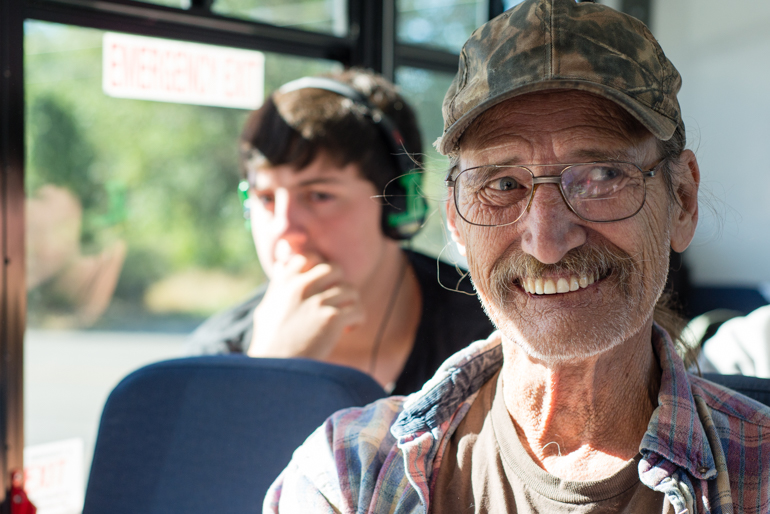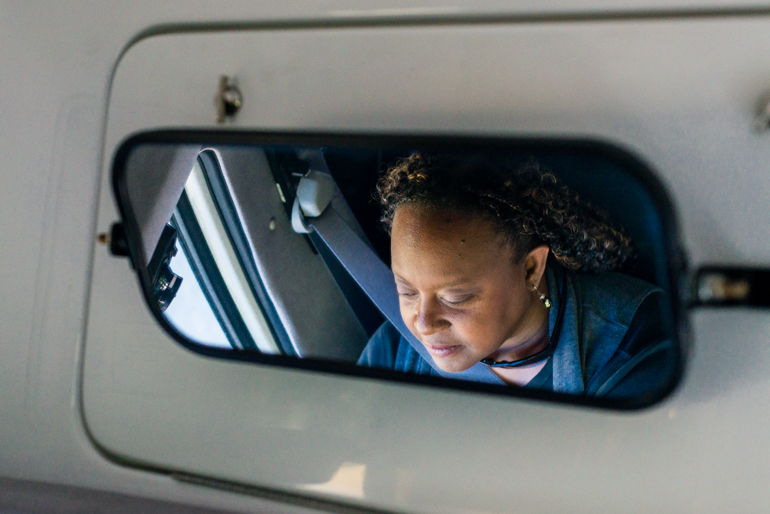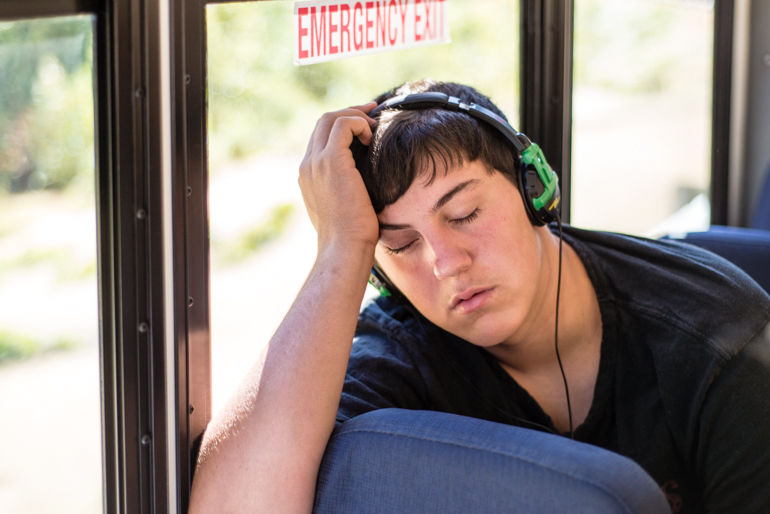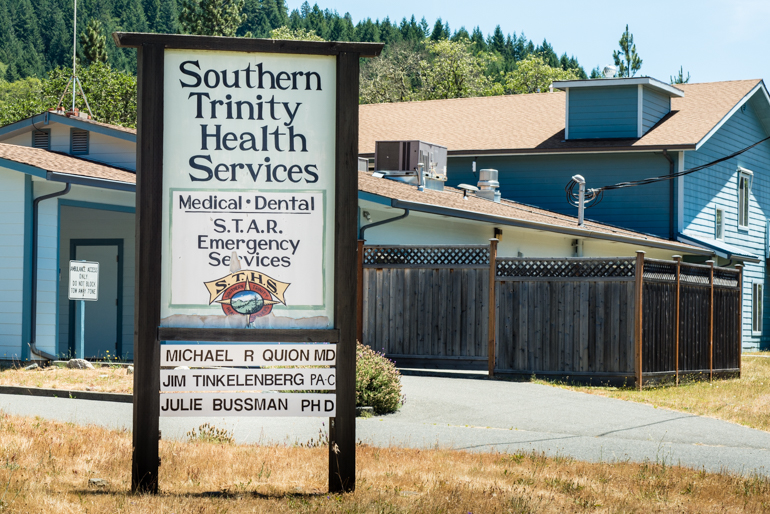HAYFORK, Calif. — It’s Tuesday morning, half past eight and already hot, when the small bus pulls up to the community clinic. Most of the passengers are waiting in front — an old man with a cane, two mothers with four kids between them, packed lunches in hand.
Two more arrive. A gray-bearded man with a pirate bandana steps from the shelter of his Subaru. A sunken-cheeked woman rushes up on her bike.
“Woohoo! We have a full car!” the driver says brightly after they’ve all climbed aboard. The riders smile back, some with a hint of resignation. It’s time for the weekly trip to the clinic in Mad River, about 30 miles down a winding mountain road near the Trinity Alps. The tight twists and turns are hard on the stomach, but even harder on the joints — especially if you have chronic Lyme disease, as more than a few of these riders do.
Jeff Clarke, the 58-year-old in the black bandana, has Lyme, acquired long ago from deer ticks that dwell in the region’s sprawling forests. But today he’s going to ask about a lump that’s been growing in his left breast. It’s starting to hurt, and he’s worried. His fellow riders list their own ailments matter-of-factly: asthma, dental decay, diabetes, drug addiction, heart disease and much more.

The rural town of Hayfork sits in the middle of the Shasta-Trinity National Forest — 200 miles north of San Francisco (Photo by Heidi de Marco/KHN).
They wouldn’t be making this trip if they didn’t have to. In Hayfork, “we’re down to the remnants of the medical personnel,” says Clarke, a well-spoken musician with a love for science, cats and NPR. “It just came to the point where if I needed to deal with anything important I just felt much more comfortable going over to Mad River.”
Like so many isolated American towns, Hayfork has lost its vitality and much of its youth to bigger places. For all its tree-lined ridges and breathtaking views, Hayfork is well beyond the tourists’ byways — more than an hour from the city of Eureka on the west and Redding on the east. It’s a 45-minute drive just to Weaverville, the tiny Trinity County seat.
Whether they’re too poor to leave or charmed by the star-filled skies, Hayforkers have mostly made their peace with isolation: No retail stores, theaters, museums, fancy restaurants – and Internet access that is iffy at best.
“We were always 20 years behind everything,” says Shannon Barnett, a 41-year-old a former school teacher who grew up here. “We were all just fine with that. Now it’s different.”
She’s referring to the exodus of basic health services.
For decades, Hayfork had been fortunate. Well after the rise of urban health systems and their intricate business models, it had a tight-knit local “system” founded on the simple, generous commitment of two people: a general practitioner and a pharmacist.
“He was everybody’s doctor,” Barnett says of Dr. Earl Mercill, a GP who moved up from the Central Valley almost 50 years ago. “You never thought about going to anyone else.”
But it’s been years since Mercill retired. Now his clinic is staffed by doctors who rotate in from Weaverville once or twice a week, and otherwise it’s run by physician’s assistants. There are no hospitals for miles, though helicopters swoop in for emergencies when needed.
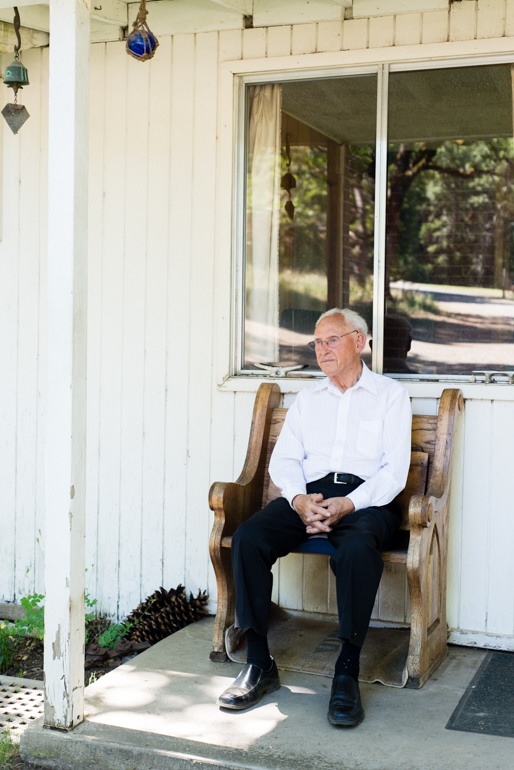
Dr. Earl Mercill, 91, was Hayfork’s only doctor for more than 30 years (Photo by Heidi de Marco/KHN).
The Mad River clinic isn’t an ideal alternative. It’s bigger than Hayfork’s and offers a wider array of services but it’s still staffed mostly by physician’s assistants and about an hour away by bus. It’s so backed up with patients it can take weeks to get an appointment, Clarke says.
In these tiny towns of California’s far north, lacking insurance is not the biggest obstacle to care. Even before Obamacare took effect, about four of five people were insured, roughly the same as in the rest of the state. A good number are on Medi-Cal.
What’s ailing these people is geography – that, and poverty. The median household income in Hayfork is about $34,000 a year, well below the statewide figure of about $60,000, according to the American Community Survey. Unemployment is extraordinarily high – estimates range between 9 and 26 percent. Many people lack a sturdy car to drive, or even money for gas.
In the federal government’s parlance, Hayfork is a “medically underserved” community – one of roughly 3,500 in the country and 170 in California, according to the federal government’s latest numbers. By definition, these areas have too few primary care providers, high infant mortality, pervasive poverty or a significant elderly population. Some are islands of deprivation within otherwise well-stocked urban areas. Others are dots on the map like Hayfork, far from where doctors and medical services are clustered. According to the National Rural Health Association, only about 10 percent of physicians practice in rural America, where nearly a quarter of the population lives.
Health care is available on the other side of the mountain, says Greg Schneider, a 65-year-old writer and band mate of Clarke’s. “The problem,” he says, “is getting there.”
Lumberjacks and Janes
In 1967, long after its rise and fall as a gold-mining town, Hayfork struck it rich. That’s when a friend told Mercill, then practicing in tiny Arvin, Calif., that an even tinier town south of Oregon badly needed a doctor.
Mercill was intrigued. He visited a few times with his large and growing family (he and his wife Marianne eventually raised eight kids, four of them adopted).
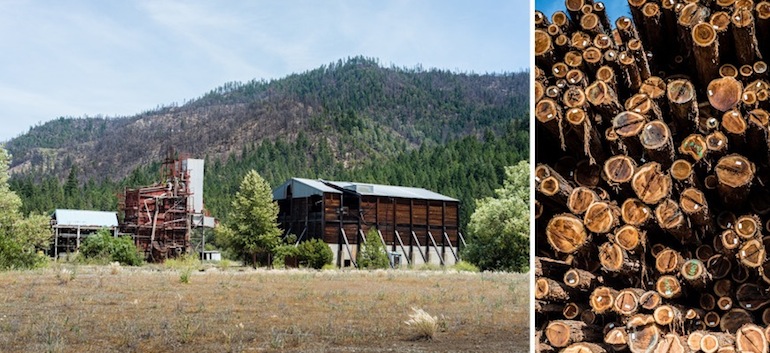
Hayfork’s timber mill, no longer in use, still stands at the edge of small town. Sierra Pacific Industries closed the mill on December 13, 1991, leaving more than 150 people out of work (Photo by Heidi de Marco/KHN).
Hayfork was still a mill town then, filled with lumberjacks and janes, as the women were known. It had restaurants, shops and even a thriving art and music scene.
After praying on the decision, the family moved up north, built a house and settled on 40 acres outside town. A few months afterward, Mercill opened his clinic downtown.
He was beloved almost from the beginning. He made house calls in the middle of the night — sometimes walking over precariously narrow log bridges or shuttling to his patients’ homes by snowmobile.
He delivered babies by flashlight after storms knocked down power and waited by his patients’ bedsides for hours until they felt better, sometimes charging little more than a slice of cake.
“If they didn’t have any money, I saw them,” Mercill recalls, frail now, but with a keen long-term memory. “If they could pay later, fine. If they didn’t, they didn’t. I never went hungry.”
Mercill couldn’t do everything, of course. If a patient needed a specialist or surgery he sent them to colleagues in Redding or Weaverville. Sometimes he drove along with them and assisted in the operating room.

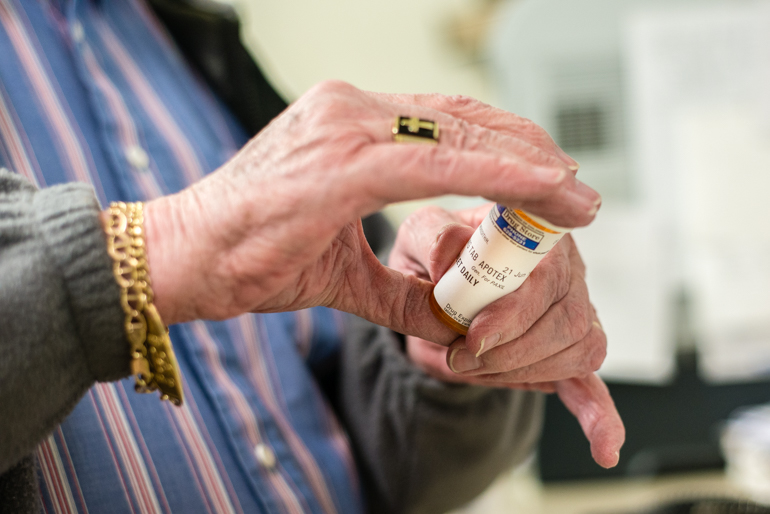
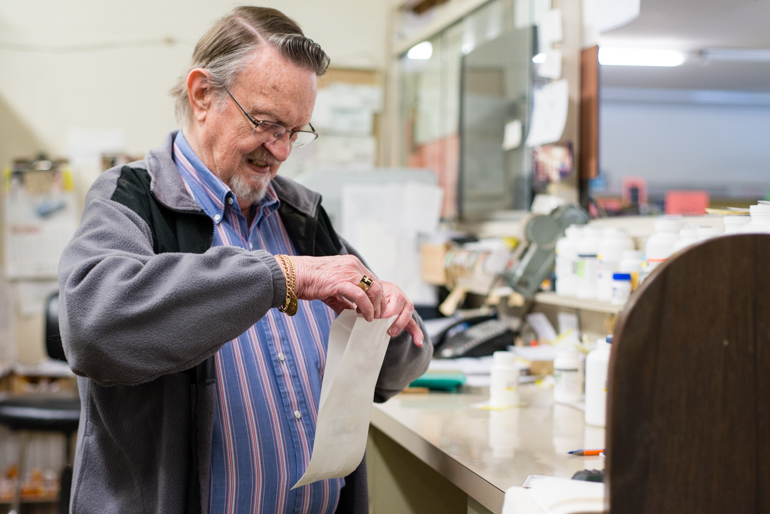
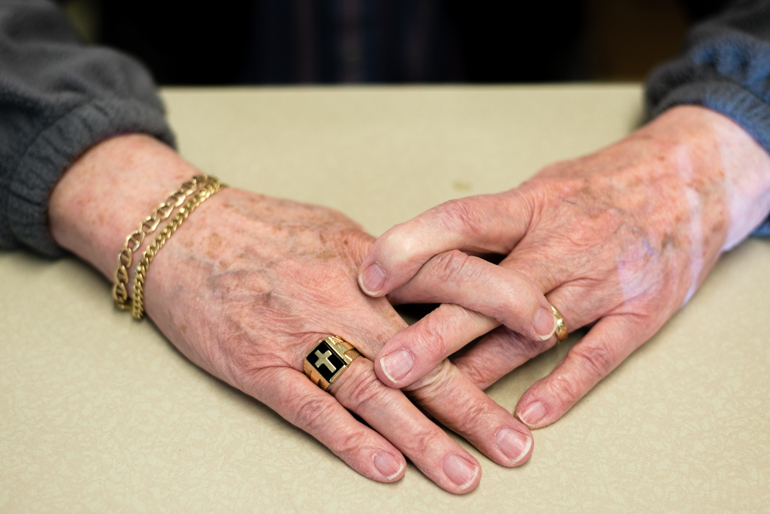
In 1982, pharmacist Gerry Reichelderfer came to Hayfork, also on a friend’s recommendation. He fell in love with mountain life, and took over the drug store next to Mercill’s clinic.
Reichelderfer lived just seven minutes and a single stop sign away from his shop. He’d drive over and open up anytime people needed a prescription. If they couldn’t pay right then, he’d put it on an I.O.U. or let it slide.
The men joined forces, talking daily by intercom. The partnership would last nearly two decades.
A Turn of Fortune
In the late 1980s, the logging industry started to crumble. Partly because of pressure from conservation groups, the mills in Northern California dominoed shut. By the time Hayfork’s mill closed in the early 1990s, the population — never higher than the low thousands — had dwindled.
“When all the workers left, they took all the families and young children,” says Rick Simmons of the Trinity County Historical Society. “What was left over was people unable to go anywhere.”
Homelessness, poverty and drug addiction took hold. An underground market began to sprout around marijuana — bringing drifters, seasonal trimmers and unofficial security forces to town. The forests became a dangerous place to wander.
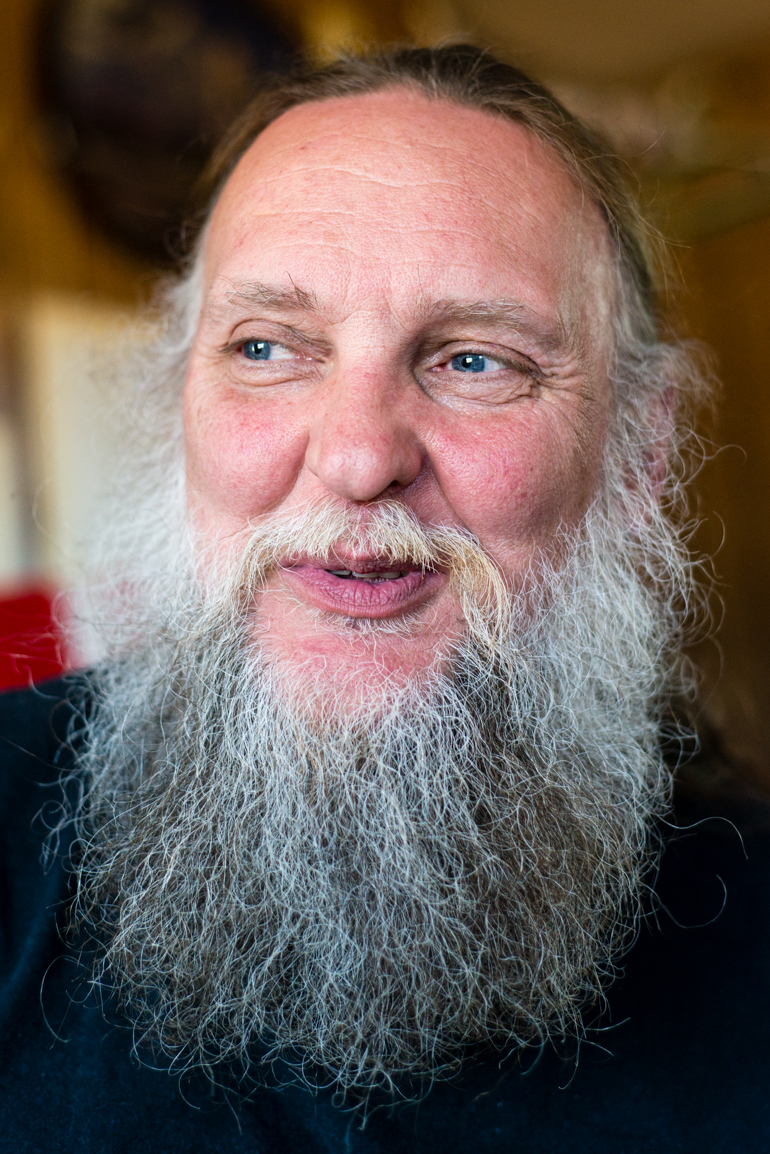
Jeff Clarke, 58, says the lack of health care in Hayfork makes it hard to treat his high blood pressure, hepatitis C and Lyme disease (Photo by Heidi de Marco/KHN).
Clarke, a runaway and hitchhiker in his youth, was in some ways typical of Hayfork’s new generation. He arrived in the 1980s, in the clutches of methamphetamine addiction, a habit he picked up in the bars where he played guitar. For years, he landed jobs and lost them — working as a wood chopper, sandwich maker and cabinet craftsman. He started seeing a woman he met in rehab, then split with her, but not before they had a daughter. They named her Stormy Brooke. He gained custody and lost it more than once.
He wanted to get sober for her, if not himself. Seeing no hope for professional help locally, he drove to a clinic in Weaverville. His first need, he told the counselor at the desk, was housing — a roof over his head.
“He repeatedly said that’s not my job,” Clarke says.
Clarke stopped trying to seek addiction treatment after that. “Most of the progress I’ve made in the last few years has been behind the 12-step stuff I do,” he says.
The meetings at Hayfork’s Solid Rock Church saved his life, he says. He goes every Monday and has been sober 10 years.
His health is ok, considering. He lost his teeth. His bottom denture wore out long ago and his top one is breaking. He has high blood pressure, a detached bicep and hepatitis C from a jailhouse tattoo. He developed chronic Lyme disease because he wasn’t treated right away with antibiotics.
Nowadays, Clarke lives behind the Trinity County Fairgrounds, in a two-room trailer next to the town cemetery. Supported by $889 a month in disability insurance, he spends his time organizing 12-step meetings, reading library books and science magazines, and volunteering as a sound engineer for gigs at a local coffee shop. On good nights, he gets paid a little. Most important to him, he says, is staying as healthy as possible so he can look after 23-year-old Stormy and her 2-year-old son, Tony, who lives with his dad.
Stormy, a tall beauty too insecure to know it, cuts herself and has made several attempts at suicide. Her porcelain arms bear the scars.
“She has no self-esteem,” Clarke says. “She has no faith in love, or trust for any other human beings. She has some real darkness inside her, you know? I’m sure I’m responsible for a majority of that.”

Stormy Clarke, 23, chooses to smoke medical marijuana to cope with her episodes of schizophrenia and bipolar depression instead of taking any prescribed pills (Photo by Heidi de Marco/KHN).
In June, during a fight with her father, she had what Jeff thought was a stroke. En route to Redding in an ambulance, she started seizing so they put her on a chopper. At the hospital, the doctors said she’d had a stress-induced seizure.
After three hours, her doctors released her with a prescription for klonopin to control her seizures and panic attacks, and told her to follow-up with her primary care physician.
“I had to laugh,” Clarke says. “We’re in Hayfork!”

Dr. Earl Mercill was honored for his years of service with a 13-foot town clock on Main Street (Photo by Heidi de Marco/KHN).
Like losing a limb
Dr. Mercill hung onto his clinic as long as he could, finally selling it to a doctor based in Weaverville. That doctor recently sold it to Trinity Hospital, part of the Mountain Communities Healthcare District, also based in the city.
The saddened community dedicated a clock to him in the town center. “It was like a limb being cut off,” Barnett says. ”I know at first I didn’t have another doctor for a long time. Other people didn’t either. They bounced around for a long time.”
Every once in a while, Mercill treated people who asked, but he’s 91 now, and hasn’t done that in years.
Two of Mercill’s kids grew up to be medical professionals – one a dentist, another a physical therapist–but they live and practice in bigger towns. The other children also moved away. One son, Steve, moved back from Southern California 21 years ago to care for his mother before she died. Now he’s caring for his dad.
Reichelderfer carried on at his pharmacy after Mercill retired, lending credit to Clarke and others when he could. But the economics of health care shifted under his feet. His business began to struggle. The reimbursements from insurers were too low, he said, and the clinic next door — a long time ally — began referring patients to bigger stores in Weaverville.
In Trinity County, where Hayfork is located, medical services overall became hard to find. In 2012, according to the Office of Statewide Health Planning and Development, there were 11 medical doctors currently practicing, roughly one per 1,200 residents. Statewide, the ratio is roughly 1 per 300.
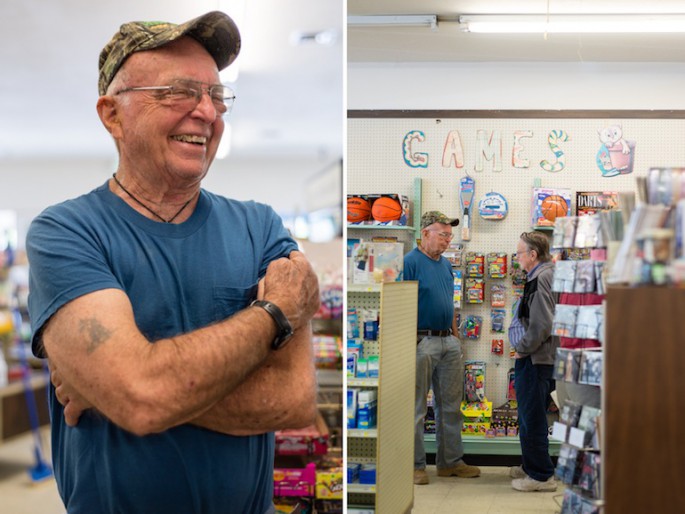
(L) Ernie Hall, 77, is a long-time customer and friend of pharmacist Gerry Reichelderfer. (R) Reichelderfer and Hall at the Hayfork Drug Store on Saturday, June 21, 2014. Reichelderfer says he knows most of his customers by name (Photo by Heidi de Marco/KHN).
Specialists like dentists and psychiatrists are nearly non-existent here. That lack of specialty care – particularly in mental health – wears on some residents. Stormy Clarke says that when she feels a panic attack or depression coming on, she simply tries to breathe deeply and distract herself by keeping busy. She also has a medical marijuana card and smokes regularly.
A county behavioral office offers counseling in Hayfork, but a counselor isn’t there every day and in-person visits are by appointment only. Sometimes the most expedient treatment comes in jail — Clarke calls it the “nudge from the judge.”
He mentions an acquaintance named Robbie, who suffers from paranoid schizophrenia. Since being released from jail, he’s been off his meds, Clarke says. He walks up and down Hayfork’s main strip along Highway 3, muttering to passers-by about the many people who are after him.
“In cities, you have places like outpatient programs for these types of people to go to, every single day,” said Julie Bussman, a psychologist at the Mad River clinic. “It’s a real hardship for people who are severely mentally ill to live out here because there’s not a lot of resources.”
In August, Bussman quit and moved back to Minnesota, leaving no psychologist for miles.
Back on the Bus

The clinic, a remodeled blue cottage, used to serve as the local forest service office (Photo by Heidi de Marco/KHN).
After the bus pulls into the Mad River clinic — a remodeled blue cottage that used to serve as a the local forest service office — the riders start their wait. They are used to it by now: The kids pull out games and books; the adults chat in the waiting room or by a weathered picnic table on the back lawn.
Everybody has to be seen before the bus can head back.
On this day, Clarke is among the first in line. The physician’s assistant on duty examines his chest lump and advises against a biopsy, an invasive procedure, because he wants to run more tests. Clarke takes the news with some concern.
“I was pretty freaked out. I went in there with the agenda of the biopsy. They wanted to explore other options,” he says afterward.
By the time the bus gets back to Hayfork, it’s mid-afternoon. He drives back to his trailer, frustrated and spent.
A few Tuesdays later, he takes the bus back to Mad River and is referred to a specialist in Weaverville.
It is another two months before he learns the lump is a side effect of the medications he’s taking — a hypothesis he’d mentioned earlier to physicians and their assistants in Hayfork and Mad River.
Now he has to start thinking about replacing those dentures, which means another bus trip — or several – around the mountain.
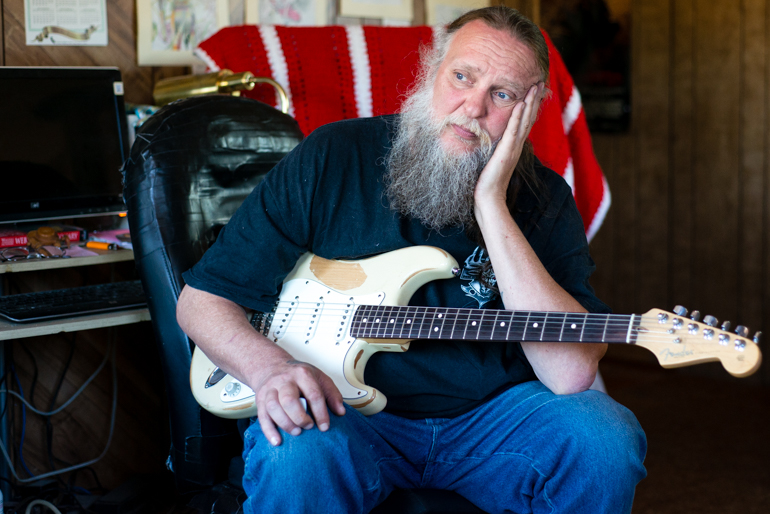
Clarke says the lack of health care in Hayfork makes it hard to treat his high blood pressure, hepatitis C and Lyme disease (Photo by Heidi de Marco/KHN).
The Final Loss
Reichelderfer, 81 and in failing health, began looking earlier this year for someone to buy his store. He looked for months. Even the independents weren’t interested, in part because pharmacists’ family members weren’t keen on moving to Hayfork.
With great sadness, he shut his doors on September 18.
“I wish I could have been able to sell it to somebody,” he said, “for the convenience of the people.”
From now on, Hayforkers will have to get a ride to Owens Pharmacy in Weaverville or to Walmart or CVS in Redding.
It took only a few days to board up a drug store open for 32 years.
It’s a relic now, standing just yards from the clock the town dedicated to Dr. Mercill, with his years of service gratefully memorialized on a plaque.
Heidi de Marco and Carol Eisenberg contributed reporting.



